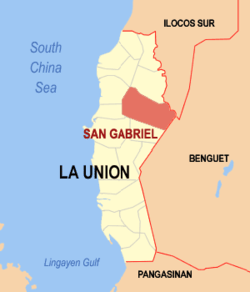San Gabriel, La Union
| San Gabriel | |||
|---|---|---|---|
| Municipality | |||
|
San Gabriel Municipal Hall | |||
| |||
 Map of La Union showing the location of San Gabriel | |||
.svg.png) San Gabriel Location within the Philippines | |||
| Coordinates: 16°40.5′N 120°24′E / 16.6750°N 120.400°ECoordinates: 16°40.5′N 120°24′E / 16.6750°N 120.400°E | |||
| Country |
| ||
| Region | Ilocos (Region I) | ||
| Province | La Union | ||
| District | 1st District | ||
| Established | 1947 | ||
| Barangays | 15 | ||
| Government | |||
| • Mayor | Divina D. Velasco | ||
| Area[1] | |||
| • Total | 129.87 km2 (50.14 sq mi) | ||
| Population (2010)[2] | |||
| • Total | 16,628 | ||
| • Density | 130/km2 (330/sq mi) | ||
| Time zone | PST (UTC+8) | ||
| ZIP code | 2513 | ||
| Dialing code | 72 | ||
| Income class | 4th class[3] | ||
The town of San Gabriel is one of the interior Municipalities of La Union. It is considered as the largest town in terms of land area.San Gabriel is at 120 20' latitude.It is bounded on the North by the Municipality of Santol with an imaginary line from a point in Ticor following the Malanas River; on the east by the Province of Benguet with an imaginary line from the Bacawayan River Junction going south following a creek to Cabassitan River up to the Barangay Duplas of San Juan La Union.Southwest by the Municipality of San Juan with an imaginary line from Duplas following the Cabassitan River westward to a point on a concrete monument near the place known as Alangigan and from this monument going north-west making an imaginary line to Sitio Bato crossing the Dayacos River and on the west by the Municipality of Bacnotan from Sitio Bato to a point in Lacong, from this point going straight with an imaginary line to Ticor, North of Sitio Matagectec, Barangay Lacong.
Barangays
San Gabriel is politically subdivided into 15 barangays.[1]
- Amontoc - Named after the rich old man, Ama Ontoc who was believed owned most of the land in the said barangay. When Ama Ontoc died he donated the whole place to the people, thus as a tribute to his generosity, the people named the said Barangay as Amontoc.
- Apayao
- Balbalayang
- Bayabas
- Bucao
- Bumbuneg
- Daking
- Lacong
- Lipay Este
- Lipay Norte
- Lipay Proper
- Lipay Sur
- Lon-oy
- Poblacion
- Polipol
History
San Gabriel was formerly known as sitio “Baka-Burnotan”, derived from “binnornutan” (English: "tug-of-war"). The sitio was the meeting place of both Christians and pagan Kankanaey settlers from nearby sitios to graze their cattle while playing the game. The name was later shortened to "burnotan". The wide plain and fertile soil attracted Christian and pagan settlers, who later intermarried which led to the increase in population.[4]
On April 19, 1897, a Roman Catholic priest Father Redondo established a church in the area and introduced the patron saint to be Saint Gabriel, from which the town was later named.[4]
In 1906, San Gabriel was made into a township under the sub-province of Amburayan in Mountain Province, with the first Presidente being Don Pablo Waggay. The township was converted into a municipal district of Amburayan in 1920, and into a municipality in 1922, following the settlement of a boundary dispute between La Union and Mountain Province. In 1947, San Gabriel was converted into a regular municipality by virtue of Executive Order No. 72 issued by President Manuel Roxas through the sponsorship of former House Speaker Pro-Tempore Francisco Ortega.[4]
Demographics
| Population census of San Gabriel | ||
|---|---|---|
| Year | Pop. | ±% p.a. |
| 1990 | 12,532 | — |
| 1995 | 13,489 | +1.39% |
| 2000 | 14,909 | +2.17% |
| 2007 | 15,803 | +0.81% |
| 2010 | 16,628 | +1.87% |
| Source: National Statistics Office[2][5] | ||
Economy
San Gabriel is an agricultural town. In its early days, the people of San Gabriel were engaged mainly in highland farming as their means of livelihood. They produced rice, corn, sweet potatoes and other root crops. As years passed, crop production decreased due to massive soil erosion in the uplands. Nevertheless, the inhabitants decided to improve their farming techniques and started making terraces. The perseverance of the people in constructing rice terraces and irrigation system along the hills and mountains of San Gabriel caused agricultural productivity to rebound.
Bananas and tiger grass are also abundant in San Gabriel, which harvests materials for soft broom production on a weekly basis.
References
- 1 2 "Province: La Union". PSGC Interactive. Makati City, Philippines: National Statistical Coordination Board. Retrieved 7 August 2013.
- 1 2 "Total Population by Province, City, Municipality and Barangay: as of May 1, 2010" (PDF). 2010 Census of Population and Housing. National Statistics Office. Retrieved 7 August 2013.
- ↑ http://www.nscb.gov.ph/activestats/psgc/province.asp?provcode=013300000
- 1 2 3 "Municipality of San Gabriel". Provincial Government of La Union: Official Website. Retrieved 5 January 2015.
- ↑ "Province of La Union". Municipality Population Data. LWUA Research Division. Retrieved 7 August 2013.
External links
| Wikimedia Commons has media related to San Gabriel, La Union. |
- Pasyalan La Union
- Philippine Standard Geographic Code
- Philippine Census Information
- Local Governance Performance Management System
 |
Santol | Sugpon, Ilocos Sur |  | |
| Bacnotan San Juan |
|
Kapangan, Benguet | ||
| ||||
| | ||||
| San Fernando | Bagulin |
| ||||||||||||||||||
